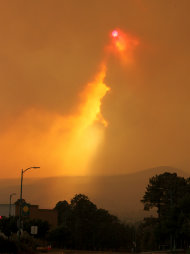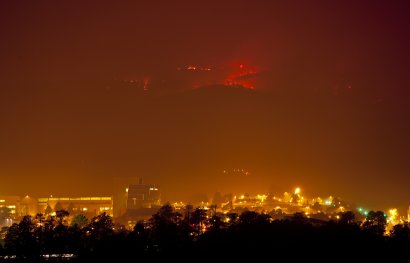
LOS ALAMOS, N.M. (AP) — A vicious wildfire spread through the mountains above a northern New Mexico town on Tuesday, driving thousands of people from their homes as officials at a government nuclear laboratory tried to dispel concerns about the safety of sensitive materials.
The wildfire — which has swelled to about 93 square miles — sparked a spot fire at the Los Alamos National Laboratory on Monday. The fire was quickly contained, and lab officials said no contamination was released and radioactive materials stored at spots on the sprawling lab were safe.
No fires burned on lab property overnight, but teams from the National Nuclear Security Administration's Radiological Assistance Program were headed to the scene to help assess any nuclear or radiological hazards, said Kevin Smith, Los Alamos Site Office manager.
"The ... teams' work will provide another level of assurance that the community is safe from potential radiological releases as the fire progresses," Smith said in a statement.
The lab will be closed through at least Wednesday, with only essential employees permitted back onto laboratory property.
The wildfire has destroyed 30 structures south and west of Los Alamos, for many stirring memories of a devastating blaze in May 2000 that destroyed hundreds of homes and buildings in town. About 12,500 residents have been evacuated from Los Alamos, an orderly exit that didn't even cause a traffic accident.
Flames were just across the road from the southern edge of the famed lab, where scientists developed the first atomic bomb during World War II. The facility cut natural gas to some areas as a precaution.
The streets of Los Alamos were empty Tuesday with the exception of emergency vehicles and National Guard Humvees. The neighborhoods were quiet, but there were signs that homeowners had left prepared. Propane bottles were placed at the front of driveways and cars were left in the middle of parking lots, away from anything flammable.

Flames from the Las Conchas fire burn in the hills above Los Alamos National Laboratory, a nuclear facility, June …
"The risk of exposure is so small. I wouldn't sit here and inhale plutonium. I may be crazy but I'm not dumb," he said.
The lab, which employs about 15,000 people, covers more than 36 square miles and includes about 2,000 buildings at nearly four dozen sites. They include research facilities, as well as waste disposal sites. Some facilities, including the administration building, are in the community of Los Alamos, while others are several miles away from the town.
The spot fire scorched a section known as Tech Area 49, which was used in the early 1960s for a series of underground tests with high explosives and radioactive materials.
Lab spokesman Kevin Roark said environmental specialists were monitoring air quality, but the main concern was smoke.
Lab personnel are monitoring the air for radionuclides and particulate matter. The lab also has monitors that can be used to check for possible radiation contamination from the fire.
The New Mexico Environment Department is monitoring the air for radioactive particles and tritium using low-volume air pumps. The state is also working with the Environmental Protection Agency and the lab to get additional ground-based monitors and an airborne monitor.
He said that the lab has taken many steps to prepare for a wildfire, including thinning trees and underbrush and surrounding key buildings with gravel to create a defensible space. Many of the buildings are also constructed to meet strict standards for nuclear safety and aggressive wildfires are taken into account, he said.
The anti-nuclear watchdog group Concerned Citizens for Nuclear Safety said the fire appeared to be about 3.5 miles from a dumpsite where as many as 30,000 55-gallon drums of plutonium-contaminated waste were stored in fabric tents above ground. The group said the drums were awaiting transport to a dump site in southern New Mexico.
Lab officials at first declined to confirm that such drums were on the property, but in a statement early Tuesday, lab spokeswoman Lisa Rosendorf said such drums are stored in a section of the complex known as Area G. She said the drums contain cleanup from Cold War-era waste that the lab sends away in weekly shipments to the Waste Isolation Pilot Plant.
She said the drums were on a paved area with few trees nearby and would be safe even if a fire reached the storage area. Officials have said it is miles from the flames.
"These drums are designed to a safety standard that would withstand a wildland fire worse than this one," Rosendorf said.
A crew that had been working at the Arizona wildfires took over efforts at the New Mexico fire Monday, about 18 hours after the blaze started.
Another firefighting team was expected to arrive Tuesday because of the potential for the blaze to more than double in size.
"That's the biggest threat we have right now to homes in the community," Deputy Los Alamos County Fire Chief Mike Thompson said late Monday of the spot fires that left hillsides above the town of Los Alamos glowing.
Thompson said containment lines created by firefighters have held despite strong wind.
"We're pretty confident on that front," he said. "We'll pre-treat with foam if necessary, but we really want the buildings to stand on their own for the most part. That is exactly how they've been designed. Especially the ones holding anything that is of high value or high risk, for the community, and really, for the rest New Mexico for that matter."
Many in the area said the current blaze reminded them of the 2000 fire that blackened about 73 square miles and destroyed hundreds of homes and buildings in the western part of the town.
"It took out all the trees and all of the greenery, and it's just now starting to come back," said Terry Langham, a retired lab technician whose house survived the 2000 fire. "Now, it's going to get burned again."
He said that wildfire in 2000 left a "burn scar" that will likely push the current blaze "a little more rapidly through the area."
The 2000 fire prompted the lab and residents to cut down trees and take other fire-prevention measures, and firefighters were hopeful that would help.
"Well, you never are safe when you have such a dry situation and you have fuel load and you have vicious winds like this," said Sen. Tom Udall, D-N.M., who visited evacuees at the Santa Claran Hotel Casino in Espanola. "When you combine all of those together, (it's) very explosive."


